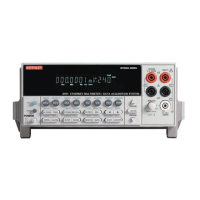6-12 Buffer Model 2701 User’s Manual
i. TRACe:DATA? Read buffer
Use TRACE:DATA? to retrieve all readings that are stored in the buffer. You can send
this command even if the instrument is still storing readings. When TRACe:DATA? is
sent, it will return the readings stored up to that point in time. Subsequent
TRACe:DATA? commands will not retrieve readings already returned. However, once
the buffer has filled and you have retrieved all buffer readings, you can again send
TRACe:DATA? to retrieve all the stored readings.
The data elements returned with each stored reading depends on which ones are
selected with FORMat:ELEMents command (see Section 14 for details).
j. TRACe:DATA:SELected? <start>, <count> Specify readings to return
TRACe:NEXT? Query location of last buffer reading
Use the TRACe:DATA:SELected? command to specify which stored readings to return.
The <start> parameter specifies the first stored reading to return. Note that the first
stored reading in the buffer is #0. The <count> parameter specifies the number of
readings to return.
When the storage process is aborted, you can use TRACe:NEXT? to determine the
buffer location for the next stored reading. For example, if the last reading is stored at
memory location #36, TRACe:NEXT? will return the value 37. This query is useful
when using the buffer in the continuous storage mode (TRACe:FEED:CONTrol
ALWays) as demonstrated by the following example.
Example — Assume the buffer is configured for continuous (wrap-around) storage and
the buffer size is 100. At some point you stop the storage process and want to return all
the readings that were stored since the last time the buffer filled. The following
command will return the buffer location for the next stored reading:
TRACe:NEXT? ’ Query buffer location for next stored
reading.
Assume that the above query returned value 37. Now you can use that value as the
<count> parameter for the following command to return the 37 readings (0 through 36):
TRACe:SELected:DATA? 0, 36 ’ Return buffer readings 0 through 36.
NOTE When using the RS-232 interface, the TRAC:DATA:SEL? command should
always be used when recalling more than 100 points of buffer data. For large
buffers, the PC may lose synchronization and data can be lost. To avoid this, use
this query command to recall buffer data in 100 point chunks.

